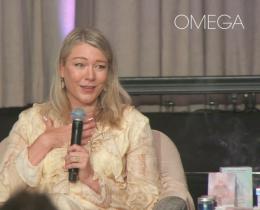We can use our body as a fortress or as a cathedral—protecting ourselves from the possibility of pain or danger, or opening ourselves to the beauty and wisdom in every cell. We’re taught to trivialize our bodily sensations because we’re afraid of suffering, eros, or narcissism. So we close ourselves off to our deepest yearnings, our desires for love and freedom, our hunger for expressing from the deepest parts of ourselves.
As coaches we can support people in honoring the intuitive wisdom emanating from their bodies. In every moment, our subconscious speaks to us through our bodies using a language that is as rich and informative as the language of our native tongue.
Our bodies communicate continuously, informing our intuition, which is also known as the sixth sense or somatic intelligence.
When we respect the body’s intelligence, we raise our consciousness and can make meaning from our immediate experience, without the filters that accompany verbal expression. Language is more abstract—one-step removed from our actual experience—because we edit, label, and summarize our somatic-emotional experience.
Instead of relying so heavily on conversation, we can facilitate growth by using the body as a rich resource to process emotions, instincts, and intuition. Listening to the full wisdom of the body reveals emotional patterns, energy shifts, and opportunities for transformation. Including the body helps people understand their needs at the cellular level and fully embody their conscious choices.
Since learning happens in the body, a daily embodiment practice helps shift an old habit to a new one.
Our desire for change starts in our body. To accept the sacred nature of our bodily experience, to attune to our body’s vibrations, gives us a felt sense of our internal wisdom that nourishes us. If we don’t know how we’re feeling, we can scan our bodies for sensations and experience the waves of energy, which invariably have a message that helps us discover our emotions. We may notice trembling, tensing, aching, or tingling in different parts of the body.
The world of thought and evaluation is a tiny fraction of the knowledge that is available to us. Paying attention to the body gives us a deeper sense of our innate wisdom. Without evaluating or manipulating our experience, or pressuring ourselves to change, we can come to new discoveries just by witnessing and opening to what is.
If we attend to the subtlest cues and stay very quiet, we come into contact with our energy. Whether we’re experiencing pure bliss, mild restlessness, or utter outrage, riding the waves of energy and honoring the emerging forces within is an act of self-respect.
An Exercise to Access Body Wisdom
You can tap the unique gifts and learning style of each person, recognizing that some have cultivated body awareness and others have a practice of armoring, ignoring, or conquering the body. In an effort to feel in control, some people hide their fear or strong feelings, ignoring their body, and spend most of their time using their heads to analyze or rationalize.
To create structures that engage people in the process of their own lives, ask questions that bring attention to the body:
- What is your body trying to tell you?
- What part of your body holds your fear?
- Where is the joy coming from in your body?
- How does anger live in your body? What shape and color is it?
- What body posture would help shift from confusion to clarity?
Using information from the body heightens self-awareness. Increased self-awareness brings natural shifts in behavior and lifestyle as people consciously choose to live their lives fully connected to their desires.



